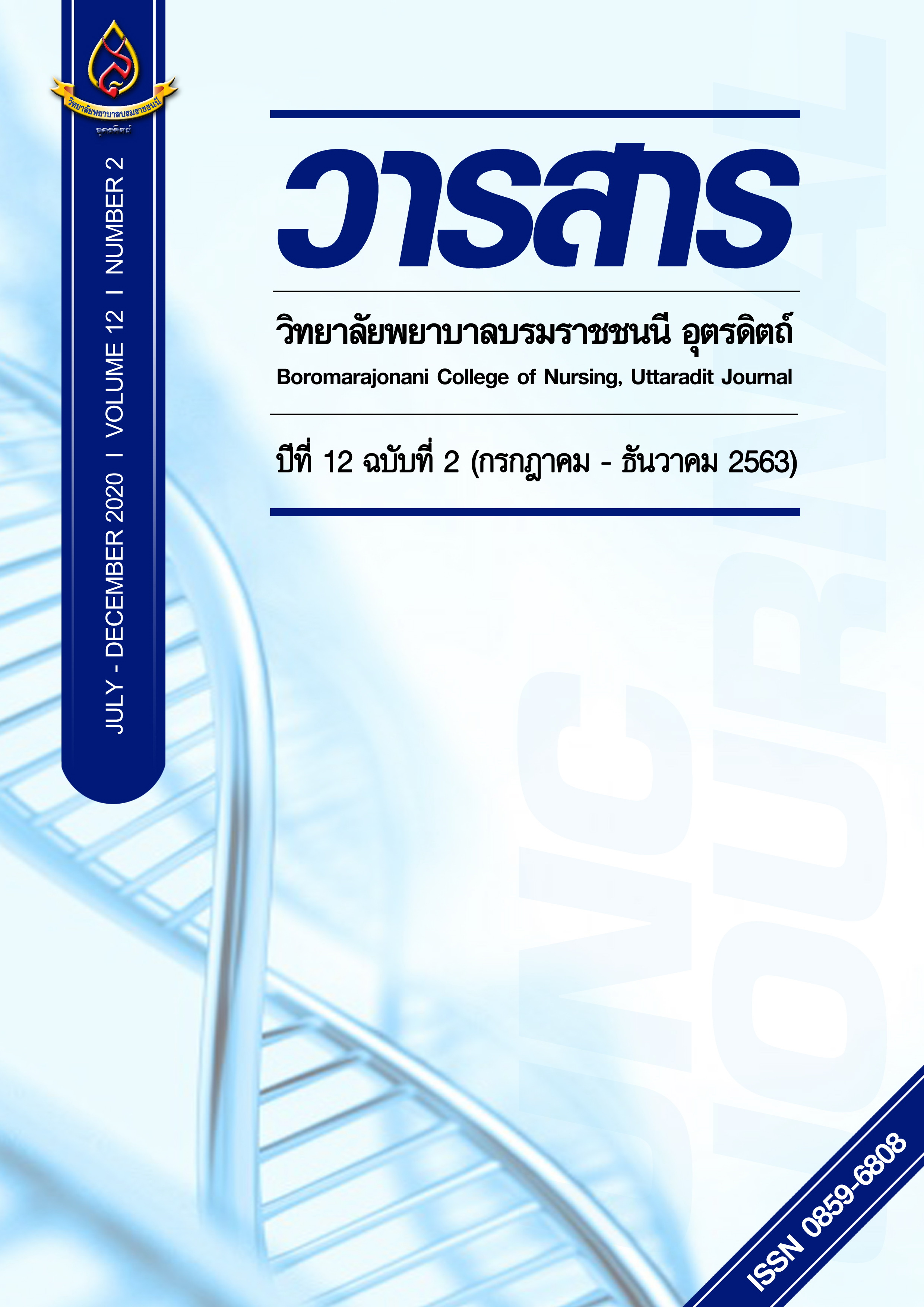ความสัมพันธ์ระหว่างความฉลาดทางสุขภาพ การรับรู้สมรรถนะแห่งตนกับ พฤติกรรมการป้องกันโรคอ้วนในนักเรียนประถมศึกษาชั้นปีที่ 4-6
Main Article Content
บทคัดย่อ
การวิจัยครั้งนี้เป็นการวิจัยเชิงพรรณนามีวัตถุประสงค์ คือ 1. เพื่อศึกษาความฉลาดทางสุขภาพในการป้องกันโรคอ้วน 2. เพื่อศึกษาพฤติกรรมการป้องกันโรคอ้วน 3. เพื่อศึกษาความสัมพันธ์ระหว่างความฉลาดทางสุขภาพ การรับรู้สมรรถนะแห่งตนกับพฤติกรรมการป้องกันโรคอ้วน กลุ่มตัวอย่างเป็นนักเรียนประถมศึกษาชั้นปีที่ 4-6 ในเขตเทศบาลเมือง จังหวัดอุตรดิตถ์ จำนวน 142 คน สุ่มตัวอย่างแบบง่าย รวบรวมข้อมูลด้วยแบบสอบถามมี 4 ส่วน ประกอบด้วย แบบสอบถามข้อมูลทั่วไป แบบสอบถามความฉลาดทางด้านสุขภาพ แบบสอบถามการรับรู้สมรรถนะแห่งตนและแบบสอบถามพฤติกรรมการป้องกันโรคอ้วนที่พัฒนาโดยกองสุขศึกษา กรมสนับสนุนสุขภาพ กระทรวงสาธารณสุข วิเคราะห์ข้อมูลโดยใช้สถิติ ค่าร้อยละ ค่าเฉลี่ย และส่วนเบี่ยงเบนมาตรฐาน วิเคราะห์หาความสัมพันธ์ปัจจัยต่าง ๆ กับพฤติกรรมการป้องกันโรคอ้วนโดยใช้ สถิติค่าสัมประสิทธิ์สหสัมพันธ์ของเพียร์สัน (Pearson’s product moment correlation)
ผลการวิจัยพบว่า 1) กลุ่มตัวอย่างมีคะแนนเฉลี่ยความฉลาดทางสุขภาพโดยรวมอยู่ในระดับปานกลาง ( X = 79.76 SD= 13.18) เมื่อพิจารณารายด้าน พบว่า ด้านความรู้ความเข้าใจทางสุขภาพ ด้านการเข้าถึงข้อมูลและบริการสุขภาพ ด้านการจัดการเงื่อนไขทางสุขภาพด้วยตนเอง และด้านการตัดสินเลือกปฏิบัติที่ถูกต้องอยู่ในระดับปานกลาง ส่วนด้านการสื่อสารเพื่อเพิ่มความเชี่ยวชาญ และการรู้เท่าทันสื่อและสารสนเทศ อยู่ในระดับต่ำ 2) กลุ่มตัวอย่างมีพฤติกรรมป้องกันโรคอ้วนอยู่ในระดับพอใช้ ( X = 64.90 SD = 8.91) 3) การวิเคราะห์ความสัมพันธ์ ความฉลาดทางสุขภาพ การรับรู้สมรรถนะแห่งตน มีความสัมพันธ์ทางบวกกับพฤติกรรมการป้องกันโรคอ้วน อย่างมีนัยสำคัญทางสถิติที่ระดับ .01 (r =.223, p=.008 , r =.446, p< .01) ตามลำดับ
Article Details
บทความหรือข้อคิดเห็นใดใดที่ปรากฏในวารสารวิจัยการพยาบาลและวิทยาศาสตร์สุขภาพ เป็นวรรณกรรมของผู้เขียน ซึ่งบรรณาธิการหรือสมาคมศิษย์เก่า ไม่จำเป็นต้องเห็นด้วย และบทความที่ได้รับการตีพิมพ์เผยแพร่ถือเป็นลิขสิทธิ์ของวารสารวิจัยการพยาบาลและวิทยาศาสตร์สุขภาพ
เอกสารอ้างอิง
2) Bandura, A. (1977). Self-efficacy: Toward a unifying theory of behavioralchange. Psychological Review, 84(2), 191–215.
3) Bandura, A. (1986). Social Foundations of thought and action. New Jersy: Prentice-Hall.
4) Barsell, D. J., Everhart, R. S., Miadich, S. A., & Trujillo, M. A. (2018). Examining health behaviors, health literacy, and self-efficacy in college students with chronic conditions. American Journal of Health Education, 49(5), 305-311 doi:10.1080/19325037.2018.1486758.
5) Chahardah-Cherik, S., Gheibizadeh, M., Jahani, S., & Cheraghian, B. (2018). The relationship between health literacy and health promoting behaviors in patients with type 2 diabetes. International Journal of Community Based Nursing & Midwifery, 6(1), 65–75.
6) Cha, E., Kim, K. H., Lerner, H. M., Dawkins, C. R., Bello, M. K., Umpierrez, G., & Dunbar, S. B. (2014). Health literacy, self-efficacy, food label use, and diet in young adults. American journal of health behavior, 38(3), 331-339. doi:10.5993/AJHB.38.3.2
7) Chaboonraung, S. (2013). Effects of a self-efficacy promoting program by peer group on food consumption and physical exercise behavior in overweight early adolescents. (master’s thesis). Bangkok: Chulalongkorn University (in Thai).
8) Chuaysrinuan, J., Chaimay, B. & Woradet, s. (2019). Health literacy towards obesity prevention among school children. Academic Journal of Community Public Health, 5(1), 1-3. (in Thai).
9) Chobthamasakul, S. (2019). Relationship between health literacy and obesity prevention behavior of undergraduate students in Bangkok metropolitan region. Journal of Interdisciplinary Research: Graduate Studies, 8(1), 116-123. (in Thai).
10) Daniel. (1995). Biostatistics: A foundation for analysis in the health sciences. 6th ed. USA: John Wiley & Sons. Inc.
11) Department of Health. (2011). Obesity disease, Metabolic syndrome,, a silent threat that you never expected. Bangkok: WVO Officer of Printing Mill. (in Thai).
12) Health Education Division. (2014). Health literacy evaluation guide for overweight Thai Children and Youth. Retrieved (2020, October 9) from http://www.hed.go.th/linkHed/361 (in Thai).
13) Inthuyod, N. (2013). General psychology. Bangkok: Chulalongkorn university press. (in Thai).
14) Ishikawa, H., Yamaguchi, I., Nutbeam, D., Kato, M., Okuhara, T., Okada, M., & Kiuchi, T. (2018).
15) Improving health literacy in a Japanese community population—A pilot study to develop an educational programme. Health Expectations, 21(4), 814–821.
doi.org/10.1111/hex.12678.
16) Khuneepong, A. (2017). Predicting factors of overweight prevention behaviors among graduate students. Journal of Safety and Health, 10(37), 58-66. (in Thai).
17) Moameang, N., Yoncharoenlump, P., & Pinij, S. (2014). The study of nutrition & student’s food consumption behavior in diamond health promoting schools at regional heath promotion center 9 Phitsanulok. Retrieved (2020, October 9) from http://hpc2.anamai.moph.go.th/research/index. php/2558/108-9 (in Thai).
18) Nutbeam, D. (2000). Health literacy as a public health goal: a challenge for contemporary health education and communication strategies into the 21st century. Health Promotion International, 15(3), 259-267. doi:10.1093/heapro/15.3.259.
19) Park, A., Eckert, T. L., Zaso, M. J., Scott-Sheldon, L. A. J., Vanable, P. A., Carey, K. B., & Carey, M. P. (2017). Associations between health literacy and health behaviors among urban high school students. The Journal of school health, 87(12), 885-893. doi:10.1111/josh.12567
20) Prasitnarapun, B., Onseng, W., Saengkhiew, P., Khiaolueang, D., Wuttijureepan, A., Khempech, U. & Wannakhao, S. (2016). Factors predicting food consumption behaviors of school students, grade 4-6. Boromarajonani College of Nursing, Uttaradit Journal, 9(2), 41-53. (in Thai).
21) Ruangchai, K. & Uttarachai, A. (2018). The relationship between Snack Seeking and Nutritional Health Promotion among fourth-sixth grade students in the Klong Luang district area, Pathum Thani province. Journal of Humanities and Social Sciences Nakhon Phanom University, 8(special issue), 103-110. (in Thai).
22) Shih, S. F., Liu, C. H., Liao, L. L., & Osborne, R. H. (2016). Health literacy and the determinants of obesity: a population-based survey of sixth grade school children in Taiwan. BMC public health, 16(280). doi:10.1186/s12889-016-2879-2
23) Sirivunnabood, P. (2018). Developmental psychology. Bangkok: Chulalongkorn university press. (in Thai).
24) Suwanwaiphatthana, W., Piromkraipak, J. & Nawanantawong, W. (2019). Health literacy and obesity prevention in junior high school: a compared study between male and female students. The Southern College Network Journal of Nursing and Public Health, 9(Special issue), 80-90. (in Thai).
25) Sutinan-opart, R. & Kitiseeworapan, P. (2016). Nutritional status and dietary behavior of primary school students under the Lampang Municipality. Payap University Research Symposium 2016. Chiangmai: Payab University. (in Thai).
26) Sutthiwarotamakul, N. (2018). The relationships between health literacy, family and peer influences and eating behavior of school-age children. Retrieved (2020, October 9) from http://www.western.ac.th/media/attachments/2018/08/20/13-2.pdf (in Thai).
27) Tipwong, A. & Numpoon, J. (2014). The associations between health literacy related to obesity and health behavior: eating and exercise in over nutritional children, Bangkok. Journal of Public Health Nursing, 28(2), 1-11. (in Thai).
28) Uttaradit Provincial Public Health Office. (2017). Annual report 2015, Public health Office Uttaradit Province. Retrieved (2017, May). from http://uto.moph.go.th/newsx/report_ year/index.php (in Thai).
29) World Health Organization. (2009). Track 2: Health literacy and health behavior. Retrieved (2020, October 9) from http://www.who.int/healthpromotion/conferences/7gchp/track2/en/


